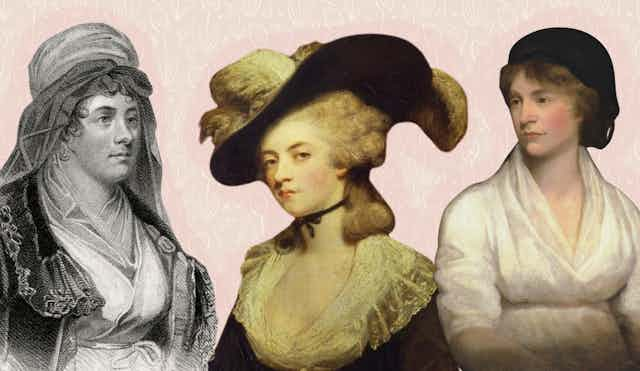The onset of the French Revolution, at the end of the 18th century, had a seismic impact on British thinking. Ideas of the nation were being hardened through xenophobia, an unquestioned reverence for institutional authority and a vocabulary of English “manliness” and “chivalry”. The publication of philosopher Edmund Burke’s Reflections on the Revolution in France (1790) reinforced this conservative stance.
But at the same time, a small but steadily growing group of thinkers vocally supported the revolution and called for similar class reforms in England. Many women writers responded to these ideas with enthusiasm. They knew that change, conservative or revolutionary, would inevitably shape gender relations and the fight for women’s rights.
Three such women, ridiculed at the time for their decisively radical writing, and celebrated for it today, are Mary Wollstonecraft, Charlotte Smith and Mary Robinson. Their novels feature defiant and non-conforming heroines, who resist the tyranny of forced marriages and indifferent parents. Ultimately, they seek moral, intellectual and economic liberation.
This reconfiguration of the heroine includes portraying them as “deviant” mothers. This was especially important at a time when the definition of “virtuous motherhood” had become increasingly restrictive. These women resisted the traditional ideas of mothering not only by writing subversively but also by rebelling against the social norms that expected them to be acquiescent mothers raising submissive daughters themselves.
1. Mary Wollstonecraft (1759-1797)
Credited as the pioneer of first-wave feminism in England, Mary Wollstonecraft is best known for her book, A Vindication of the Rights of Woman (1792). But Wollstonecraft also wrote a fictional parallel to this work.

Maria: or the Wrongs of Woman (1798) chronicles the life of a woman who is married to an abusive husband. He publicly “proves” her mad, so she is confined in an asylum and can no longer see their infant daughter. Hopeless in prison, Maria writes a manuscript to her daughter, recording episodes from her harrowing life.
The warden at the asylum, Jemima, is a lower-class woman, born out of wedlock and stigmatised from birth. She grows up an impoverished orphan and is sexually abused by her stepfather and later by her employer. Her rape results in pregnancy and she aborts the child. The novel is a bleak commentary on the cyclical nature of sexual violence inflicted on mothers like Jemima and Maria, who live in the shadows of civil society.
We know her as the mother of the novelist Mary Shelley, but before her marriage to William Godwin, Wollstonecraft too had given birth to a daughter out of wedlock. While caring for her infant, Fanny, she coped with the abandonment of Fanny’s biological father. Her autobiographical travel writing, Letters Written in Sweden, Norway, and Denmark (1796), was composed during this difficult period and dedicates extensive sections to her experiences as a new mother.
2. Charlotte Smith (1749-1806)
Charlotte Smith was unhappily married to a gambling addict, and of the 12 children born in this troubled marriage, only nine survived.

Her life as a writer was marked by desperation, as she struggled to support her children and grandchildren and fought a lifelong legal battle for her father-in-law’s property. Smith wrote prolifically and her novels portray women at various stages of their lives, from older matriarchs leading the family to young mothers and women who give birth outside marriage.
These are often sympathetic portrayals, and the narrator doesn’t make a moral commentary. For instance, in Emmeline (1788), one of the characters who gives birth to an “illegitimate” child is reunited with her lover and given a happy ending. This is transgressive as the norm was to depict “promiscuous” women as suffering and dying to caution young women readers.
Desmond (1792), Smith’s most overtly political novel, goes even further in its rebellion. Its English hero unequivocally sympathises with the revolutionaries in France. Moreover, he falls in love in love with a young mother of three children. There’s a convergence of personal and political liberation as the plot unfolds.
3. Mary Robinson (1757-1800)
Much like Smith and Wollstonecraft, Mary Robinson championed women’s rights, education and autonomy. She acquired celebrity status as a stage actress and was dubbed “Perdita” after the Shakespearean heroine. As a poet, she earned the informal title “the English Sappho”.

Her initial journey as an author resembles Smith’s. Robinson was coerced to marry young, to a man deep in gambling and debt. When he failed to repay his debts and was imprisoned, Robinson was sent to prison with him. However, she took the unusual step of taking her infant daughter to prison with her rather than leaving her in a state care home, as was convention.
Robinson’s eventual rise to literary and theatrical stardom was accompanied by an unconventional personal life, as she separated from her husband and had several affairs. Unlike Smith, who presented herself as a self-sacrificing and chaste single mother to the public, Robinson became a sexualised actress and author, an even more “deviant mother”. Her memoirs were posthumously published by her daughter.
Robinson’s novel, The Natural Daughter (1799), set in the backdrop of the French Revolution, portrays a newly married heroine who takes an unmarried mother’s baby under her care in order to protect both the mother and the baby. When the biological mother goes missing, rumours arise that the baby is her own from an illicit affair, leading to the breakdown of her marriage.
The novel follows the lives of both women, the adoptive mother who faces shame and social ostracism, and the biological one who rises to fame as an actress – much like Robinson herself.

Looking for something good? Cut through the noise with a carefully curated selection of the latest releases, live events and exhibitions, straight to your inbox every fortnight, on Fridays. Sign up here.

